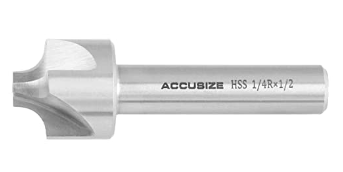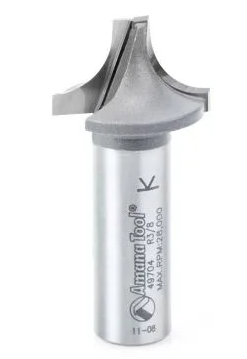I don't have a radius tool, but probably will very soon. Kind of feel like I have to learn a bit about the way the village elders of the past had to do it first before going straight to technology. I don't have a mill but correct me if I'm wrong. I could get a ball end mill and chuck it in the tailstock to make a concave form in a small .250 T circular or square plate on the lathe and there's my base?I think there is an easier way to do it, since you don't have a radius turner.
Buy some bearing balls to use as your spherical joint element. Use a ball end mill to machine a hemisphere in the all thread, if you must. A simple conical recess will do the job and leave a void to fill with grease.
-
Welcome back Guest! Did you know you can mentor other members here at H-M? If not, please check out our Relaunch of Hobby Machinist Mentoring Program!
You are using an out of date browser. It may not display this or other websites correctly.
You should upgrade or use an alternative browser.
You should upgrade or use an alternative browser.
Freehand radius ends
- Thread starter usamech
- Start date
- Joined
- Feb 1, 2015
- Messages
- 9,601
I cut the conical dish using the compound. I have a ball turner that could have been used to cut both a convex and concave feature. The reason for the conical interface is that the contact area is close to the center where any torque due to friction is minimized. The same principle used by watch makers for their bearings.The dished surface was just slightly shallower than the conical point ensuring first contact at the center.I like this idea. Other ideas are great too, but I've already committed to the radiused end months ago when I built this dolly, and the fact that I have already made two yesterday. Was mostly looking for good techniques on how to make the radius by hand and see if I was on the right track. I just didn't know how best to make the radius. I made the other two today and got much faster and more efficient with it.
I'll probably scrap the washer idea and try to dish or make a concave cut in .250 plates. Is yours actually conical or a concave arc? If conical, how do you cut it? Guessing it's a combined crosslide and compound slide movement? This would be a new cut for me. By the way, I don't have a mill. Thanks!
Usamech
Not having a ball turner, you can improvise by loosening the compound pivot and adjusting the compound to cut the radius you need. It should work fine for the small radii you want.
Speaking of radius tool attachments, any opinions on this attachment from Little Machine Shop? Sorry, I couldn't properly copy the link.
I have a Clausing 5917, so I need something that can affix to an Aloris AXA 1/2" tool holder.
OMW Large Radius Ball Tool

 littlemachineshop.com
littlemachineshop.com
I have a Clausing 5917, so I need something that can affix to an Aloris AXA 1/2" tool holder.
OMW Large Radius Ball Tool

Lathe Radius Turning Tool | Lathe Ball Turning Attachment
This lathe radius turning tool is sized for lathes of 5" or greater swing with a .5" shank size that will fit most standard tool holders. Order for your workshop today.
So, if I read correctly, a convex surface mating in a conical form means more weight per surface area, but smaller contact surface, thus minimized friction...sort ofI cut the conical dish using the compound. I have a ball turner that could have been used to cut both a convex and concave feature. The reason for the conical interface is that the contact area is close to the center where any torque due to friction is minimized. The same principle used by watch makers for their bearings.The dished surface was just slightly shallower than the conical point ensuring first contact at the center.
Not having a ball turner, you can improvise by loosening the compound pivot and adjusting the compound to cut the radius you need. It should work fine for the small radii you want.
Brings my thoughts back to my early planning stages months ago, I was looking for carriage bolts to use like your idea but couldn't find them in a diameter I thought was large enough.
- Joined
- Feb 1, 2015
- Messages
- 9,601
The friction is about the same but the torque is decreased because torque is the product of the applied force, friction in this case, and the distance from the pivot point. With the force concentrated at the pivot point, the distance is essentially zero, hence minimal torque. Simialar in principle to using a dead center on a lathe.So, if I read correctly, a convex surface mating in a conical form means more weight per surface area, but smaller contact surface, thus minimized friction...sort of
Brings my thoughts back to my early planning stages months ago, I was looking for carriage bolts to use like your idea but couldn't find them in a diameter I thought was large enough.
- Joined
- Nov 24, 2014
- Messages
- 3,156
I don't have a radius tool, but probably will very soon. Kind of feel like I have to learn a bit about the way the village elders of the past had to do it first before going straight to technology. I don't have a mill but correct me if I'm wrong. I could get a ball end mill and chuck it in the tailstock to make a concave form in a small .250 T circular or square plate on the lathe and there's my base?
Yes, you are correct. Or, you can just chamfer the hole.
- Joined
- Jul 28, 2017
- Messages
- 2,368
Since you've got a lot of adjustment in your design you could easily switch to a cone on the ends of your remaining pieces. Up to you of course.I like this idea. Other ideas are great too, but I've already committed to the radiused end months ago when I built this dolly, and the fact that I have already made two yesterday. Was mostly looking for good techniques on how to make the radius by hand and see if I was on the right track. I just didn't know how best to make the radius. I made the other two today and got much faster and more efficient with it.
I'll probably scrap the washer idea and try to dish or make a concave cut in .250 plates. Is yours actually conical or a concave arc? If conical, how do you cut it? Guessing it's a combined crosslide and compound slide movement? This would be a new cut for me. By the way, I don't have a mill. Thanks!
Usamech
Just rotate the compound to some angle, I'd suggest something that will give you 45 degree or greater included angle. Since you'd be machining the half-angle that would be 22.5 degrees or more, relative to the spindle axis. Then machine the cone by advancing the compound.
- Joined
- Nov 23, 2014
- Messages
- 2,606



